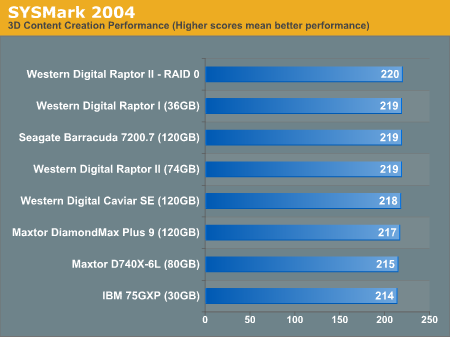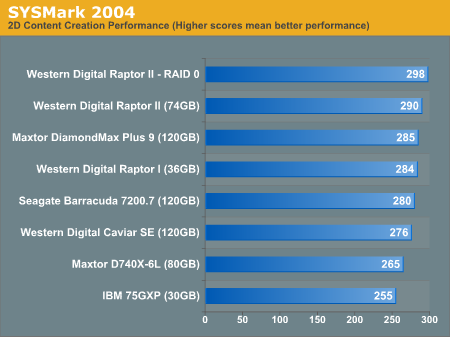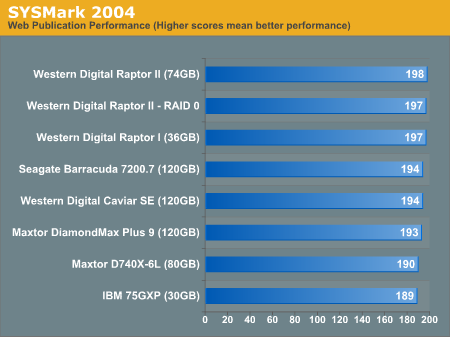Western Digital's Raptors in RAID-0: Are two drives better than one?
by Anand Lal Shimpi on July 1, 2004 12:00 PM EST- Posted in
- Storage
Overall System Performance - SYSMark
SYSMark 2004 is divided into two separate suites: Internet Content Creation and Office Productivity. What makes SYSMark an ideal hard disk benchmark is that its scores are totals of response times, meaning that the benchmark measures how long the system takes to respond to a task (e.g. how long before a search and replace is completed after it is initiated) and sums up all such response times to generate a score. This score is generated for six total subcategories: three under Internet Content Creation and three under Office Productivity.For the most part, SYSMark is CPU/platform bound, but we will see some variations in performance according to disk speed. At the same time, there are a couple of benchmarks within SYSMark that are heavily disk dependent.
First, we start with Internet Content Creation performance; the first category that we will deal with is 3D Content Creation. The tests that make up this benchmark are described below:
"The user renders a 3D model to a bitmap using 3ds max 5.1, while preparing web pages in Dreamweaver MX. Then the user renders a 3D animation in a vector graphics format."

As we've seen in the past, 3D content creation performance is rarely influenced by hard disk speed (unless your workstation is grossly underpowered in memory size), and thus, we see no improvement from a two-drive RAID-0 array.
Next, we have 2D Content Creation performance:
"The user uses Premiere 6.5 to create a movie from several raw input movie cuts and sound cuts and starts exporting it. While waiting on this operation, the user imports the rendered image into Photoshop 7.01, modifies it and saves the results. Once the movie is assembled, the user edits it and creates special effects using After Effects 5.5."

There's a small 2.8% performance boost from RAID-0 here, but once again, nothing to write home about and nothing worth the added cost.
The Internet Content Creation suite is rounded up with a Web Publishing performance test:
"The user extracts content from an archive using WinZip 8.1. Meanwhile, he uses Flash MX to open the exported 3D vector graphics file. He modifies it by including other pictures and optimizes it for faster animation. The final movie with the special effects is then compressed using Windows Media Encoder 9 series in a format that can be broadcast over broadband Internet. The web site is given the final touches in Dreamweaver MX and the system is scanned by VirusScan 7.0."

Once again, we're left with virtually identical performance between the RAID-0 and single drive Raptor configurations. The average of our three SYSMark runs have actually left the single drive Raptor II slightly ahead of the RAID-0 array, but that's normal variation between the benchmark runs.










127 Comments
View All Comments
timw - Thursday, July 8, 2004 - link
This isn't really anything new. As someone else mentioned, seek time and cache size with the right firmware optimizations are the most important. RAID 0 won't be able to improve that, and may actually be slower than a single drive in many instances. If you don't believe what Anandtech has to say, take a look at the latest article at storagereview.com.Pumpkinierre - Thursday, July 8, 2004 - link
Wrong again, mdrohn, Australia to be exact, but I was using an Oxford dictionary. The hyperdictionary.com (USA based I think as it advertises cheap dental insurance for US residents) gives redundancy as:Definition: [n] repetition of an act needlessly
[n] the attribute of being superfluous and unneeded; "the use of industrial robots created redundancy among workers"
[n] (electronics) a system design that duplicates components to provide alternatives in case one component fails
[n] repetition of messages to reduce the probability of errors in transmission
Which agrees with both our definitions. Yours is more correct electronically. Hyperdictionary has a more extensive electronic description but doesnt add much more to the above electronic definition:
http://www.hyperdictionary.com/dictionary/redundan...
I'm at odds with that electronic meaning of redundancy. After all the language came before the electronics.
mdrohn - Thursday, July 8, 2004 - link
Heh, I guess that means you are writing from Britain, Pumpkinierre. That special meaning of 'redundancy' in the workplace context of someone losing their job is unknown here in the USA. In fact I'd never heard it in my life until watching 'The Office' on DVD last month ;) We call that layoffs or downsizing here.The electronics/systems meaning I posted was also taken straight from a dictionary.
Pumpkinierre - Thursday, July 8, 2004 - link
Your job becomes redundant when you are no longer of use. You then get a redundancy payout based on the years worked etc.. So I think they initially used the term to describe drives that were no longer of use as they had been replaced by newer bigger drives. My dictionary has redundant as meaning superfluous which is more like your definition, #100, and I suppose you could regard a backup drive as such....until your main drive lets go. So, I dont like the usage of redundancy for duplexed or mirrored drives.mdrohn - Wednesday, July 7, 2004 - link
"Redundancy means of no further use."Actually, 'redundant' more precisely means 'exceeding what is required' or 'exactly duplicating the function or meaning of another', which is an important distinction.
'Redundancy' in an electronics or systems context means 'incorporating extra components that perform the same function in order to cope with failures and errors'. Thus RAID 0 is not, strictly speaking, a 'redundant' array of disks despite its RAID name, since every drive in RAID 0 records different data. RAID 1 is classic redundancy--all the drives in a RAID 1 array are reading and writing exactly the same data.
Pumpkinierre - Wednesday, July 7, 2004 - link
I dont know about that latency increase with RAID. Seek times dont seem to be much affected in reviews I've seen. If the controller reads the drives simultaneously then there shouldnt be much effect on latency.(will it make it to the 6th page?!)
masher - Wednesday, July 7, 2004 - link
> I'm fairly certain that the performance> advantages of having 4 or 5 striped drives are
> likely to be a lot better than just 2...
No, not for ATA drives. You're still limited to the max bandwidth of 133MB/s (150 for some SATA implementations), so beyond 3 drives you don't get the full transfer rate of each drive. Plus, the latency gets worse the more drives you add...with 5 or more drives, your mean latency is essentially your max latency of any single drive.
So a larger array is a repeat of the 2-drive situation. Its much faster in the rare case of a disk-bound app transferring huge files...and no faster (or possibly slightly slower) the rest of the time.
You are right on one thing though. Cheaper (translation: slower) disks would tend to look a bit better here. Not a huge difference, but the slower the disk, the more likely the app is to be disk-bound.
kapowaz - Wednesday, July 7, 2004 - link
Perhaps the review ought to have pointed out what RAID stands for: Redundant Array of *Inexpensive* Disks. The idea is to improve the performance or reliability of a system by using many smaller/cheaper disks compared to using a single expensive disk. Often this isn't the case (I doubt anyone would say the 15krpm disks in modern servers are 'inexpensive'), but the origin behind the technology remains applicable today.Maybe a better test would be to take some cheap disks and see how well they perform. Also, am I not right in thinking that SATA RAID allows for more than just two devices? I'm fairly certain that the performance advantages of having 4 or 5 striped drives are likely to be a lot better than just 2...
masher - Wednesday, July 7, 2004 - link
Umm, MadAd...The "array" of drives can't fail unless a drive in it fails...and it will always fail if one of its drives does. Its just a logical grouping, not a separate entity.Furthermore, MTBF is the wrong statistic to use here. MTTF is the relevant one.
Obviously the raid controller itself could fail, but this is outside the scope of the argument. And such a failure is highly unlikely to impact data in any case.
MadAd - Tuesday, July 6, 2004 - link
"But when we are talking about an ARRAY of drives, the operating life of each individual drive in the array is not what is at issue. What is relevant is ARRAY failure, not DRIVE failure."Are you also trying to say that if the array fails without a drive failing then thats still down to the drives MTBF? wouldnt that be an array MTBF?
If a drive fails in Raid0 then of course we expect the array will fail. If a drive does not fail but the array fails (and you can reuse the drive) then thats nothing to do with the drives MTBF is it? The drives not failed, its still got service life, the array failed. You'll need a different way to measure the chance of an array failure since (unless its connected with a drive failure) its nothing to do with the expected longevity of the components that we measure by drive manufacturers MTBF figures of service life.